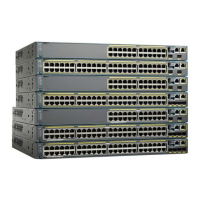•
Deny ACEs that check Layer 4 information never match a fragment unless the fragment contains Layer
4 information.
ACEs and Fragmented and Unfragmented Traffic Examples
Consider access list 102, configured with these commands, applied to three fragmented packets:
Switch(config)# access-list 102 permit tcp any host 10.1.1.1 eq smtp
Switch(config)# access-list 102 deny tcp any host 10.1.1.2 eq telnet
Switch(config)# access-list 102 permit tcp any host 10.1.1.2
Switch(config)# access-list 102 deny tcp any any
In the first and second ACEs in the examples, the eq keyword after the destination address means to test
for the TCP-destination-port well-known numbers equaling Simple Mail Transfer Protocol (SMTP) and
Telnet, respectively.
Note
•
Packet A is a TCP packet from host 10.2.2.2., port 65000, going to host 10.1.1.1 on the SMTP port. If
this packet is fragmented, the first fragment matches the first ACE (a permit) as if it were a complete
packet because all Layer 4 information is present. The remaining fragments also match the first ACE,
even though they do not contain the SMTP port information, because the first ACE only checks Layer
3 information when applied to fragments. The information in this example is that the packet is TCP and
that the destination is 10.1.1.1.
•
Packet B is from host 10.2.2.2, port 65001, going to host 10.1.1.2 on the Telnet port. If this packet is
fragmented, the first fragment matches the second ACE (a deny) because all Layer 3 and Layer 4
information is present. The remaining fragments in the packet do not match the second ACE because
they are missing Layer 4 information. Instead, they match the third ACE (a permit).
Because the first fragment was denied, host 10.1.1.2 cannot reassemble a complete packet, so packet B
is effectively denied. However, the later fragments that are permitted will consume bandwidth on the
network and resources of host 10.1.1.2 as it tries to reassemble the packet.
•
Fragmented packet C is from host 10.2.2.2, port 65001, going to host 10.1.1.3, port ftp. If this packet is
fragmented, the first fragment matches the fourth ACE (a deny). All other fragments also match the
fourth ACE because that ACE does not check any Layer 4 information and because Layer 3 information
in all fragments shows that they are being sent to host 10.1.1.3, and the earlier permit ACEs were checking
different hosts.
ACLs and Switch Stacks
ACL support is the same for a switch stack as for a standalone switch. ACL configuration information is
propagated to all switches in the stack. All switches in the stack, including the active switch, process the
information and program their hardware.
Active Switch and ACL Functions
The active switch performs these ACL functions:
•
It processes the ACL configuration and propagates the information to all stack members.
Catalyst 2960-X Switch Security Configuration Guide, Cisco IOS Release 15.0(2)EX
146 OL-29048-01
Configuring IPv4 ACLs
ACLs and Switch Stacks
